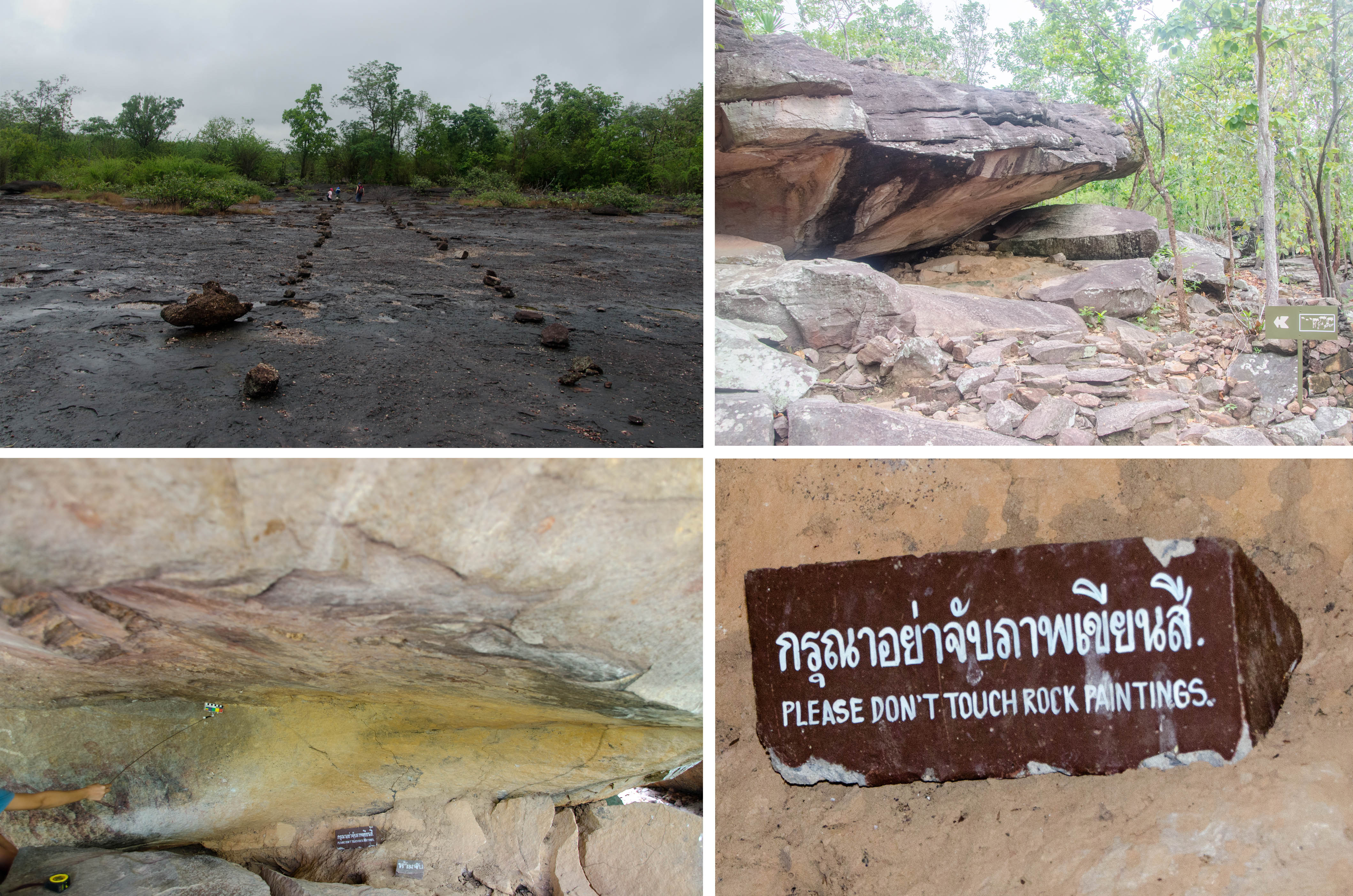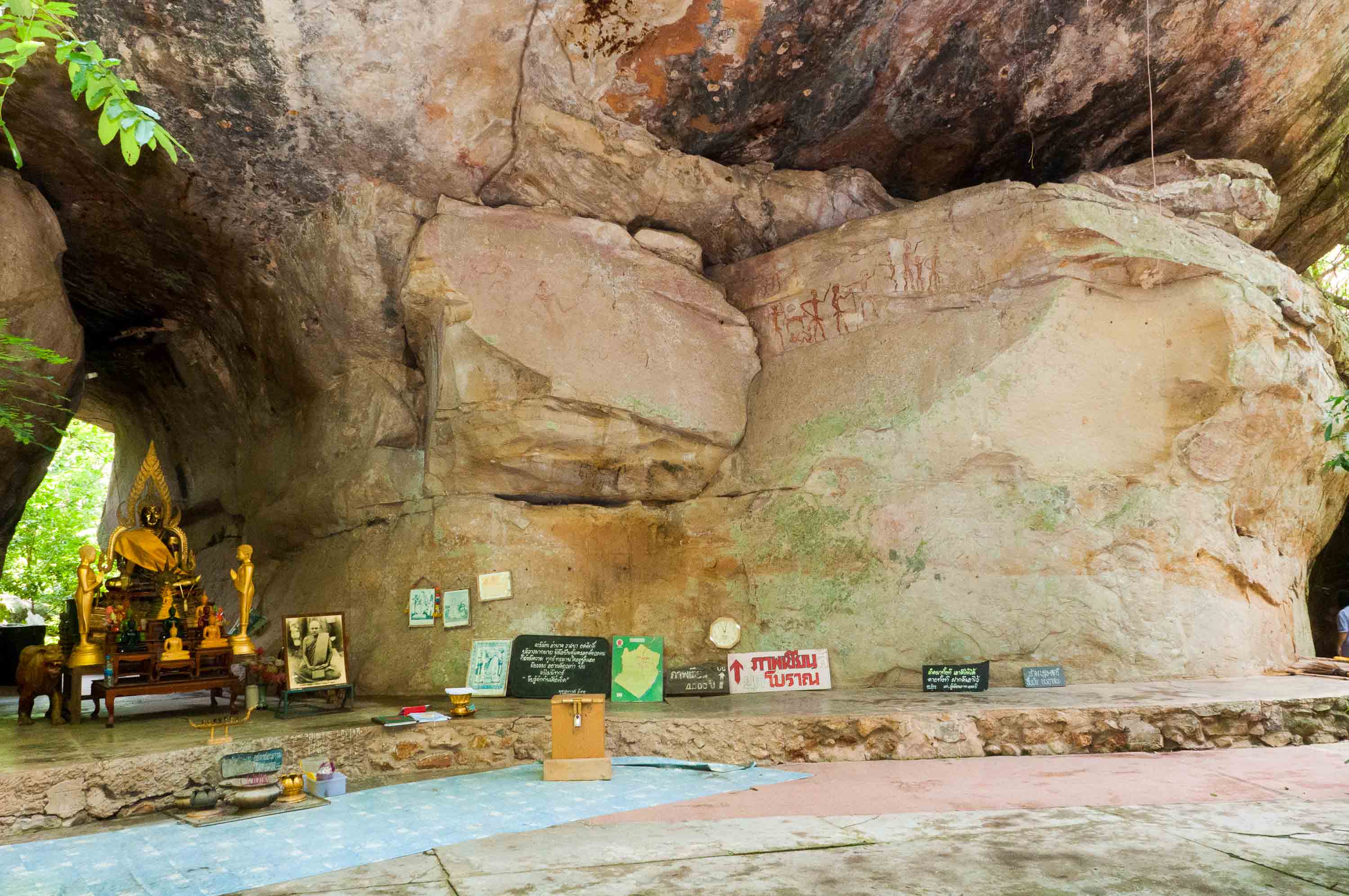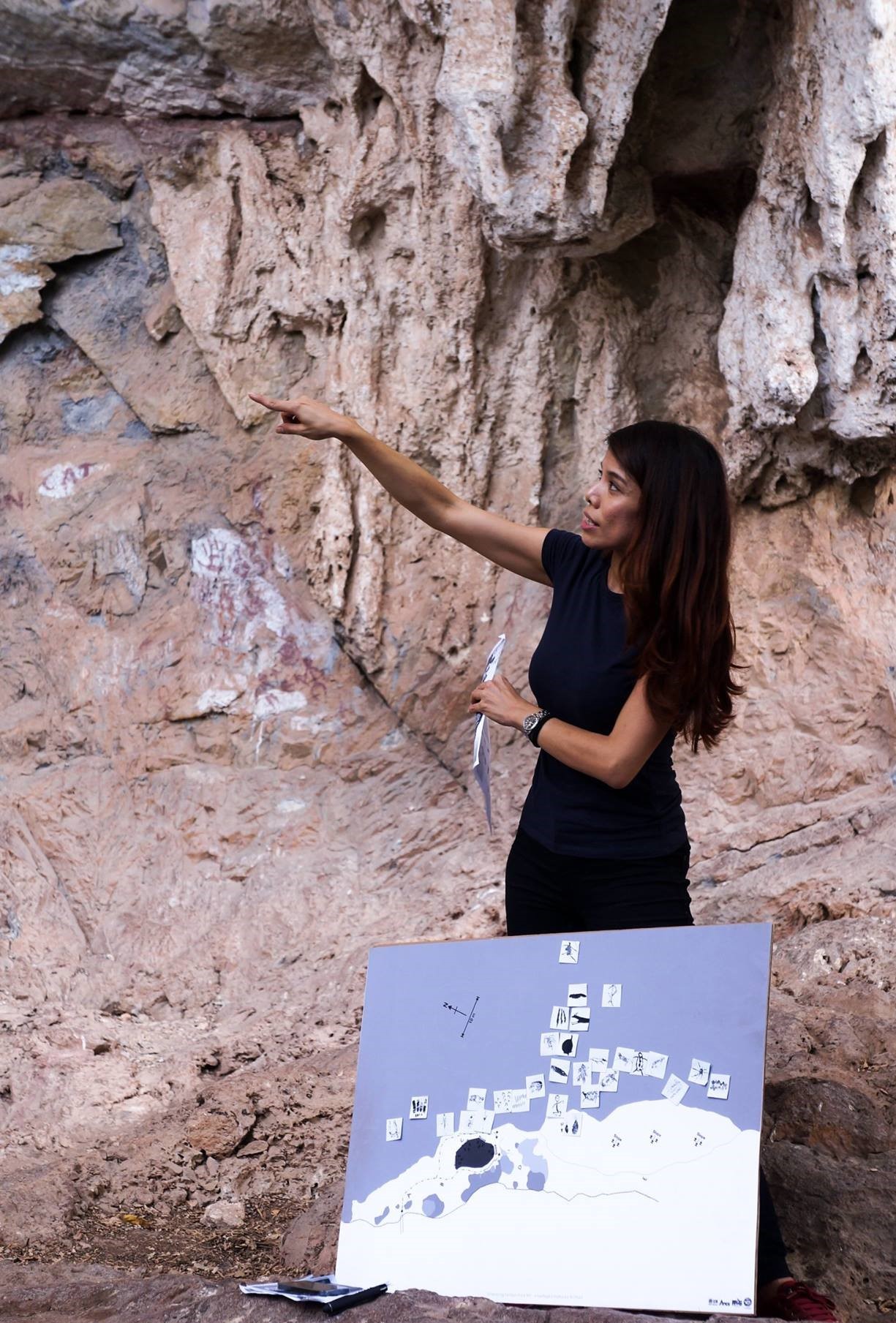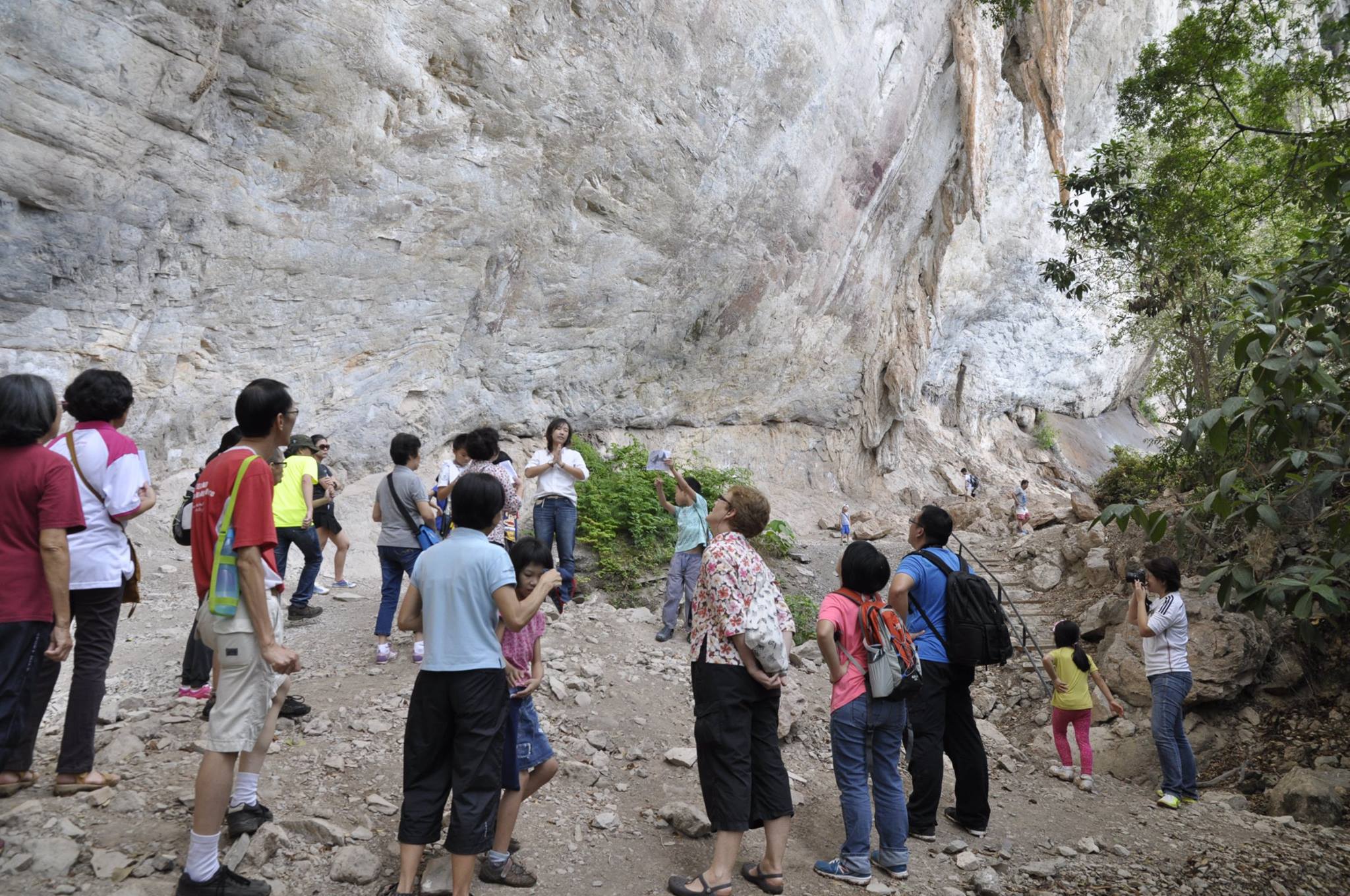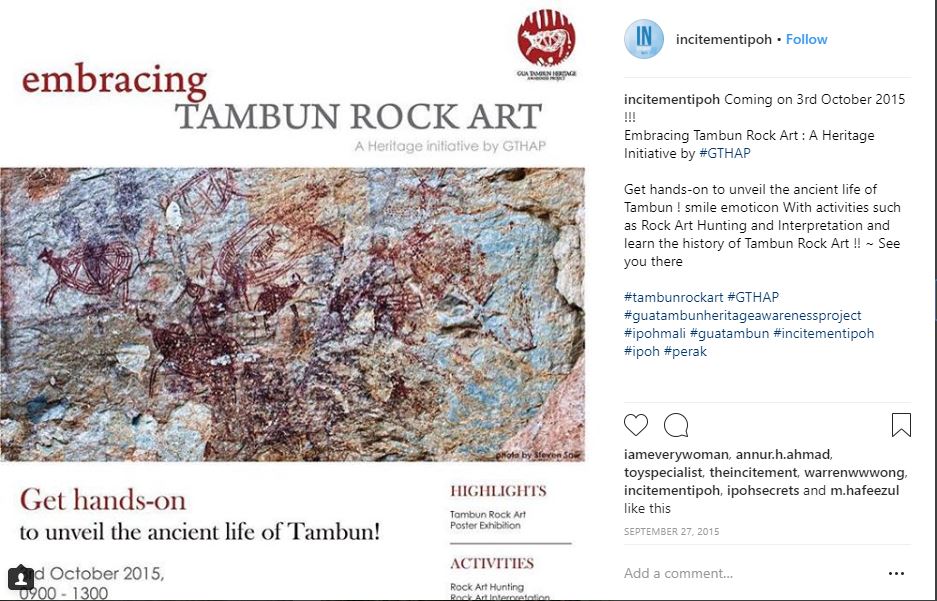
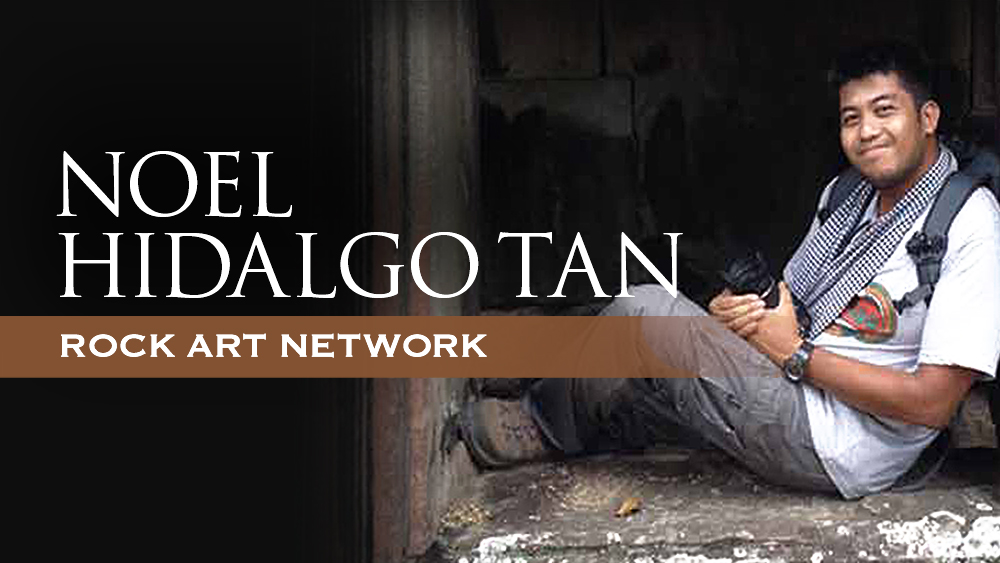
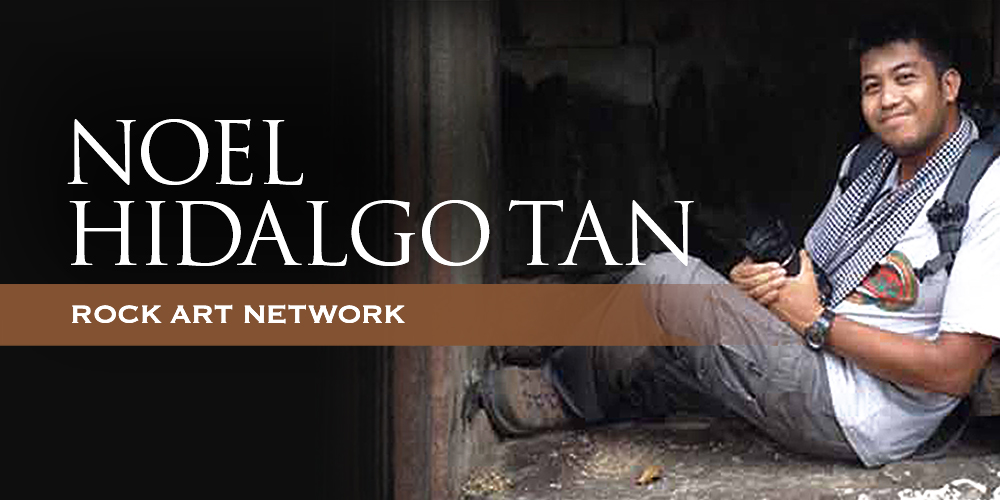
by Noel Hidalgo Tan
Senior Specialist in Archaeology, Southeast Asian Regional Centre for Archaeology and Fine Arts (SEAMEO SPAFA), Thailand
Archaeological studies in Southeast Asia began as part of the colonial experience initially oriented toward studying temple architecture and sculpture. In later, postcolonial times, archaeology has become a source of national pride and revenue through tourism. Against this background, rock art has traditionally been under-researched. In the past decade, there has been a marked increase in site discoveries and research publications from both local and international scholars (see overviews by Scott and Tan 2016; Tan 2014b; Taçon and Tan 2012). Rock art is now known in nearly every country in Southeast Asia; most rock art is thought to be from the Late Holocene to the Neolithic, although there is evidence of rock art from the Pleistocene (Aubert et al. 2014; O’Connor et al. 2010) to the more recent colonial period (Tan and Walker-Vadillo 2015; Mokhtar Saidin and Taçon 2011).
Southeast Asia is a diverse region, and as a result, rock art research and its management varies from country to country. In this paper, I will outline some successful rock art management and communication strategies from Southeast Asia. They are divided into two approaches: traditional strategies involving physical site management and co-opting local beliefs into the protection of sites; and new media strategies utilizing the internet and social media to engage people in caring for and monitoring sites. This latter strategy has potential for future development, particularly in the case for managing sites that are open to tourists.
Phu Phra Bat in Udon Thani Province, Thailand. Various signs and tourist trails are designed to direct tourist behavior.
The Phu Phra Bat site (“The Mountain of Buddha’s Footprints”) was established in 1991 as a historical park and is a sandstone ridge located in Udon Thani Province in northeastern Thailand. The site has a number of natural, historical, and cultural features, including magnificent rock formations—many of which have been converted into Buddhist and animist shrines—architectural ruins from two ancient kingdoms, and some one hundred rock art sites. Taken together, Phu Phra Bat represents a sacred landscape that has been used over a long period of time (Tan and Taçon 2014; Tan 2014a; Munier 1998).
Khao Chan Ngam in Nakhon Ratchasima Province, Thailand, a rock art site protected by a Buddhist shrine.
Dr. Goh Hsiao Mei of Universiti Sains Malaysia leading one of the weekend public archaeology workshops at the Gua Tambun rock art site in Ipoh, Malaysia.
The Khao Chan Ngam site (“Mountain of the Beautiful Moon”) in Thailand’s Nakhon Ratchasima Province is a large sandstone massif containing rock art scenes of huntergatherer lifestyles. At the same time, the rock shelter houses a Buddhist shrine with numerous Buddha images. A number of other signs and posters outlining the history of the temple and stories of prominent monks are laid along the wall of the shrine.
The shrine effectively protects the rock art by preventing access and interference (fig. 2). Both the archaeological and the religious value of the site are acknowledged. The shrine is part of a larger temple complex that is maintained by the monastic community, while the Fine Arts Department has placed the rock art on the official register of protected sites and provided signs to inform visitors about the site.
Similar coexistence of rock art sites and Buddhist shrines can be found in Myanmar, Cambodia, and Laos (Tan 2014a; Tan and Taçon 2014) and has been observed elsewhere with other religions in India (Peter Skilling, pers. comm. 2017), Kazakhstan (Lymer 2004), and East Timor (O’Connor, Pannell, and Brockwell 2011). When a site becomes a sacred space, the religious activity protects the rock art from physical damage by preventing access to the rock art; however, religious activities at sites tend to be indifferent to the presence of rock art and may modify the actual site itself. In this regard, local custodians of the site play an important role in understanding the significance of the rock art. By educating them about the importance of the rock art, local custodians also become invested in the long-term preservation and protection of these sacred spaces (fig. 3).
The protection of a rock art site through association with a sacred space, while fairly common in Southeast Asia, is a regionally specific phenomenon. In addition, protection of the rock art is not the intention of the religious actors at the site but rather a by-product of maintaining a location’s sanctity. For a more direct approach to raising public awareness and protecting sites, the internet and social media present new opportunities for connecting people with sites and experts. A prime example is the ongoing Gua Tambun Heritage Awareness Project (GTHAP) in Perak, Malaysia.
GTHAP is an initiative developed by the Centre for Global Archaeological Research at Universiti Sains Malaysia. Gua Tambun is a cliffside rock shelter located outside of Ipoh, the capital of the state of Perak in central peninsular Malaysia. Discovered in 1959, a reexamination of the site in 2009 recorded the presence of more than six hundred paintings, making it the largest rock art site in peninsular Malaysia; from associated finds, the site is dated from the Late Holocene to Early Neolithic period (Matthews 1960; Tan and Chia 2012, 2011, 2010; Tan 2010). In response to the new findings from the 2009 campaign and heightened awareness of the management and conservation issues at the site, GTHAP was launched in 2015.
Gua Tambun Heritage Awareness Project community site visits in Perak, Malaysia. Photo: Gua Tambun Heritage Awareness Project.
The researchers at GTHAP identify a gap in the sense of ownership of Gua Tambun between the researchers and the people who live there now (Goh 2016). Through the GTHAP workshops, Saw et al. argue that encouraging public interpretation of the rock art also raises social awareness and ownership of the rock art sites. At the time of writing, the public archaeology workshops at Gua Tambun are undergoing a fourth season, lasting from March to December 2017.
A contributing factor to the success of the Gua Tambun Heritage Awareness Project is the role of social media in spreading the word and connecting people across space; the researchers at Universiti Sains Malaysia are based in Penang, two states away, but through their efforts they have facilitated an understanding of the often inaccessible academic literature and increased local-level appreciation of the site.
Social media can promote community engagement with rock art sites. The use of hashtags tracks activities associated with sites and makes them more discoverable.
From personal experience, members of the public—often interested tourists—have reached out to me via my personal website (Tan 2007), Academia.edu, and institutional e-mail to ask about rock art sites they have encountered. In one example, an Austrian tourist who visited Laos in the middle of 2016 saw a rock art site in Luang Prabang Province. Through her internet searches, she found my research and contacted me for more information. As it turns out, the site she visited was known but as yet undocumented (Bouxaythip 2011) and her information led directly to a baseline recording of the site (Tan 2016).
The flow of information shared between the public and researchers works both ways. After reading an article I published about the Karimun Inscription, a petroglyph site in the Riau Islands of Indonesia, near Singapore (Tan 2007), a Buddhist monk was inspired to visit the site and contacted me. I later found out through his blog post that he did visit the site with some of his followers, but unfortunately poured water over the rock engravings and attempted to trace over the carvings (Dhammika 2013). While I could not have foreseen the actions of the monk and his followers, the Karimun Inscription episode is a reminder that obscurity is a great protector of rock art sites. On reflection, social media can play an important role in educating visitors at rock art sites on the proper behavior to promote the preservation of sites.
Underlying the two traditional and new media approaches outlined above is not so much the management of the physical site itself but rather the management of people connected to the rock art sites. The key task for the site manager is engagement with the authorities, local custodians, and visitors. In the case of Southeast Asia, traditional, on-the-ground engagement with local religious and community leaders has an important role to play in the long-term protection of sites; moreover, the cooperation of religious custodians is the single most important protection sites can have from physical interference.
The internet and social media have an equally profound potential for managing visitors, particularly with sites that are already open to tourists. Strategies for use, communicating rock art values, and managing sites fall under four broad categories: raising awareness, creating communities, generating calls to action, and site monitoring.
Raising awareness: In the Southeast Asian experience, rock art is generally unknown and hence undervalued. Therefore, social media and the internet play an important part in creating appreciation of undervalued sites and in educating potential visitors on how to visit and appreciate such sites. Caution and judgment must be used, however, in determining if opening a site to public knowledge exposes it to unnecessary risk.
Creating communities: GTHAP is a successful example of mobilizing a local and international community through the creation of a Facebook page and an Instagram account, and developing a follower base around the site. Care should be taken in choosing the right kinds of online community platforms according to the audience patterns. Community members in turn become vested in the long-term welfare of the site, and a channel from which more publicity and awareness are shared. Generating calls to action: With a large enough follower base, social media can be used to mobilize actions such as clean-up activities, fundraising, and organizing community events. Such events should be designed to generate publicity in order to enlarge the existing community.
Site monitoring: For heavily visited sites, social media can be used to monitor rock art and site degradation through photos shared between community members. Most social media outlets offer some way of tracking the number of followers, but hashtags (#s) should also be propagated and monitored to track specific activities and sites (fig. 5). Watermarking images with hashtags and website addresses are also useful methods of spreading important information.
Aubert, Maxime, Adam Brumm, Muhammad Ramli, Thomas Sutikna, E. Wahyu Saptomo, Budianto Hakim, Michael J. Morwood, Gerrit D. van den Bergh, Leslie P.J. Kinsley, and Anthony Dosseto. 2014. Pleistocene cave art from Sulawesi, Indonesia. Nature 514 (7521): 223–27.
Bautista, Angel P. 2015. Current status of archaeology in the Philippines. In Advancing Southeast Asian Archaeology 2013: Selected Papers from the First SEAMEO SPAFA International Conference on Southeast Asian Archaeology, Chonburi, Thailand 2013, edited by Noel Hidalgo Tan, 207–14. Bangkok: SEAMEO SPAFA Regional Centre for Archaeology and Fine Arts.
Bouxaythip, Souliya. 2011. “The Significant Rock Art in the Lao PDR Presented at the Training.” Paper presented at the Training/Workshop on the Introduction to Rock Art Studies in Southeast Asia, SEAMEO SPAFA, Bangkok, Thailand, 2–13 May.
Dhammika, Shravasti. 2013. “The Karimun Inscription.” Dhamma Musings (10 March). http://sdhammika.blogspot.com/2013/03/the-karimun-inscription.html
Goh, Hsiao Mei. 2016. The pitfalls and prospects of community heritage engagement in Malaysian archaeology. In Workshop on the Heritage of Ancient and Urban Sites: Giving Voice to Local Priorities. Singapore: ISEAS.
Lester, Robert C. 1973. Theravada Buddhism in Southeast Asia. Ann Arbor: University of Michigan Press.
Lymer, Kenneth. 2004. Rags and rock art: The landscapes of holy site pilgrimage in the Republic of Kazakhstan. World Archaeology 36 (1): 158–72.
Matthews, J. M. 1960 A Note on Rock Paintings Recently Discovered Near Ipoh, Perak, Federation of Malaya. Man 60: 1-3.
Mokhtar Saidin, and Paul S. C. Taçon. 2011. The recent rock drawings of the Lenggong Valley, Perak, Malaysia. Antiquity 85 (328): 459–75.
Munier, Christophe. 1998. Sacred Rocks and Buddhist Caves in Thailand. Bangkok: White Lotus. The Nation. 2015. “Phu Phra Bat Park Nominated for Unesco Heritage Site List.” The Nation [Thai Portal] (27 January). http://www.nationmultimedia.com/national/Phu-Phra-Bat-Park-nominated-for-Unesco-Heritage-Si-30252745.html
O’Connor, Sue, Ken Aplin, Emma St. Pierre, and Yue-xing Feng. 2010. Faces of the ancestors revealed: Discovery and dating of a Pleistocene-age petroglyph in Lene Hara Cave, East Timor. Antiquity 84 (325): 649–65.
O’Connor, Sue, Sandra Pannell, and Sally Brockwell. 2011. Whose culture and heritage for whom? The limits of national public good protected area models in Timor Leste. In Rethinking Cultural Resource Management in Southeast Asia: Preservation, Development, and Neglect, edited by John N. Miksic, Geok Yian Goh, and Sue O’Connor, 39–66. Anthem Southeast Asian Studies.
London: Anthem Press.
Scott, V., and Noel Hidalgo Tan. 2016. Recent rock art studies in Southeast Asia. In Rock Art Studies: News of the World 5, edited by Paul G. Bahn, Natalie R. Franklin, Matthias Strecker, and E. G. Dėvlet, 163–70. Archaeopress Archaeology. Oxford: Archaeopress Publishing Ltd.
Sitthisunthō̜n, Phindā [Pindar Sidisunthorn], Simon Gardner, and Dīn Samāt [Dean Smart]. 2006. Caves of Northern Thailand. Bangkok: River Books.
Taçon, Paul, and Noel Hidalgo Tan. 2012. Recent rock art research in Southeast Asia and southern China. In Rock Art Studies: News of the World 4, edited by Paul G. Bahn, Natalie R. Franklin, and Matthias Strecker, 207–14. Oxford: Oxbow.
Tan, Noel. 2007. “The Karimun Inscription.” SEAArch: The Southeast Asian Archaeology Newsblog (15 April). http://www.southeastasianarchaeology.com/2007/04/15/indonesia-karimun-inscription/
Tan, Noel Hidalgo. 2010. Scientific Reinvestigation of the Rock Art at Gua Tambun, Perak. Volume 1: New Research. Master’s thesis, Universiti Sains Malaysia, Penang, Malaysia.
Tan, Noel Hidalgo. 2014a. Painted Sites, Sacred Sites: An Examination of Religious Syncretism in Southeast Asia through Rock Art Site Usage. PhD diss., Australian National University.
Tan, Noel Hidalgo. 2014b. Rock art research in Southeast Asia: A synthesis. Arts 3 (1): 73–104.
http://www.mdpi.com/2076-0752/3/1/73
Tan, Noel Hidalgo. 2015. Report on the Newly-Discovered Rock Art Site of Gabarni, Shan State, Myanmar.
Unpublished. SEAMEO SPAFA, Bangkok.
Tan, Noel Hidalgo. 2016. “The Rock Art of the Nam Ou, Luang Prabang, Laos.” https://www.researchgate.net/project/The-Rock-art-of-the-Nam-Ou-Luang-Prabang-Laos
Tan, Noel Hidalgo, and Stephen Chia. 2010. “New” rock art from Gua Tambun, Perak, Malaysia. Rock Art Research 27 (1): 9–18.
Tan, Noel Hidalgo.. 2011. Current research on the rock art at Gua Tambun, Perak, Malaysia. Bulletin of the Indo-Pacific Prehistory Association 31: 93–108.
Tan, Noel Hidalgo. 2012. Revisiting the rock art at Gua Tambun, Perak, Malaysia. In Crossing Borders: Selected Papers from the 13th International Conference of the European Association of Southeast Asian Archaeologists, Volume 1, edited by Mai Lin Tjoa-Bonatz, Andreas Reinecke, and Dominik Bonatz, 181–98. Singapore: NUS Press.
Tan, Noel Hidalgo, and Paul S. C. Taçon. 2014. Rock art and the sacred landscapes of mainland Southeast Asia. In Rock Art and Sacred Landscapes, edited by Donna L. Gillette, Mavis Greer, Michele Helene Hayward, and William Breen Murray, 67–84. One World Archaeology. New York: Springer.
Tan, Noel Hidalgo, and Veronica Walker-Vadillo. 2015. The curious case of the steamship on the Mekong. Asian Perspectives: Journal of Archeology for Asia & the Pacific 54 (2): 253–73.
Wichakana, M., ed. 1994. `Utthayan prawattisat Phu Phrabat = Phu Phra Bat Historical Park, `Ekkasan Kong Borannakhadi. [Bangkok]: Krom Sinlapakon.
→ Members and affiliated institutions of the Rock Art Network
by
George Nash
5/09/2024 Recent Articles
→ Sigubudu: Paintings of people with guns in the northern uKhahlamba-Drakensberg
by Aron Mazel
22/07/2024
by Richard Kuba
13/06/2024
by Meenakshi Dubey-Pathak
8/03/2024
by Rock Art Network
6/02/2024
by Rock Art Network
14/12/2023
by Sam Challis
5/12/2023
by Aron Mazel
30/11/2023
by Sam Challis
21/11/2023
by Sam Challis
15/11/2023
by Sam Challis
10/11/2023
by Rock Art Network
6/11/2023
by Rock Art Network
3/11/2023
by Aron Mazel
2/11/2023
by Meenakshi Dubey-Pathak
26/09/2023
by Paul Taçon
24/08/2023
by Aron Mazel
13/06/2023
by Paul Taçon
5/06/2023
by Paul Taçon
15/03/2023
by George Nash
14/03/2023
by Noel Hidalgo Tan
10/02/2023
by George Nash
01/02/2023
by Meenakshi Dubey-Pathak, Pilar Fatás Monforte
29/11/2022
by Aron Mazel, George Nash
21/09/2022
by Paul S.C. Taçon, Sally K. May, Ursula K. Frederick, Jo McDonald
07/07/2022
by Meenakshi Dubey-Pathak
26/07/2022
by Paul Taçon
20/07/2022
by David Coulson
16 June 2022
by Paul Taçon
25 April 2022
by Noel Hidalgo Tan
20 April 2022
by Meenakshi Dubey-Pathak
14 March 2022
by Carolyn Boyd & Pilar Fatás
02 March 2022
by David Coulson
07 February 2022
by Johannes H. N. Loubser
06 February 2022
by Meenakshi Dubey-Pathak
05 February 2022
by Aron Mazel
28 January 2022
by Aron Mazel
8 September 2021
by David Coulson
17 August 2021
by Ffion Reynolds
21 June 2021

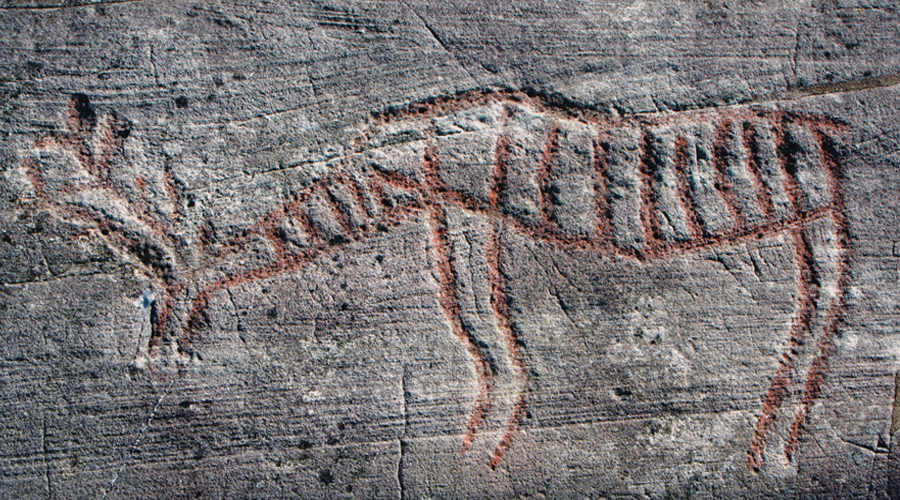
by Aron Mazel
22/07/2024
by Richard Kuba
13/06/2024
by Meenakshi Dubey-Pathak
8/03/2024
by Rock Art Network
6/02/2024
by Rock Art Network
14/12/2023
by Sam Challis
5/12/2023
by Aron Mazel
30/11/2023
by Sam Challis
21/11/2023
by Sam Challis
15/11/2023
by Sam Challis
10/11/2023
by Rock Art Network
6/11/2023
by Rock Art Network
3/11/2023
by Aron Mazel
2/11/2023
by Meenakshi Dubey-Pathak
26/09/2023
by Paul Taçon
24/08/2023
by Aron Mazel
13/06/2023
by Paul Taçon
5/06/2023
by Paul Taçon
15/03/2023
by George Nash
14/03/2023
by Noel Hidalgo Tan
10/02/2023
by George Nash
01/02/2023
by Meenakshi Dubey-Pathak, Pilar Fatás Monforte
29/11/2022
by Aron Mazel, George Nash
21/09/2022
by Paul S.C. Taçon, Sally K. May, Ursula K. Frederick, Jo McDonald
07/07/2022
by Meenakshi Dubey-Pathak
26/07/2022
by Paul Taçon
20/07/2022
by David Coulson
16 June 2022
by Paul Taçon
25 April 2022
by Noel Hidalgo Tan
20 April 2022
by Meenakshi Dubey-Pathak
14 March 2022
by Carolyn Boyd & Pilar Fatás
02 March 2022
by David Coulson
07 February 2022
by Johannes H. N. Loubser
06 February 2022
by Meenakshi Dubey-Pathak
05 February 2022
by Aron Mazel
28 January 2022
by Aron Mazel
8 September 2021
by David Coulson
17 August 2021
by Ffion Reynolds
21 June 2021
Friend of the Foundation


by Aron Mazel
22/07/2024
by Richard Kuba
13/06/2024
by Meenakshi Dubey-Pathak
8/03/2024
by Rock Art Network
6/02/2024
by Rock Art Network
14/12/2023
by Sam Challis
5/12/2023
by Aron Mazel
30/11/2023
by Sam Challis
21/11/2023
by Sam Challis
15/11/2023
by Sam Challis
10/11/2023
by Rock Art Network
6/11/2023
by Rock Art Network
3/11/2023
by Aron Mazel
2/11/2023
by Meenakshi Dubey-Pathak
26/09/2023
by Paul Taçon
24/08/2023
by Aron Mazel
13/06/2023
by Paul Taçon
5/06/2023
by Paul Taçon
15/03/2023
by George Nash
14/03/2023
by Noel Hidalgo Tan
10/02/2023
by George Nash
01/02/2023
by Meenakshi Dubey-Pathak, Pilar Fatás Monforte
29/11/2022
by Aron Mazel, George Nash
21/09/2022
by Paul S.C. Taçon, Sally K. May, Ursula K. Frederick, Jo McDonald
07/07/2022
by Meenakshi Dubey-Pathak
26/07/2022
by Paul Taçon
20/07/2022
by David Coulson
16 June 2022
by Paul Taçon
25 April 2022
by Noel Hidalgo Tan
20 April 2022
by Meenakshi Dubey-Pathak
14 March 2022
by Carolyn Boyd & Pilar Fatás
02 March 2022
by David Coulson
07 February 2022
by Johannes H. N. Loubser
06 February 2022
by Meenakshi Dubey-Pathak
05 February 2022
by Aron Mazel
28 January 2022
by Aron Mazel
8 September 2021
by David Coulson
17 August 2021
by Ffion Reynolds
21 June 2021
Friend of the Foundation
